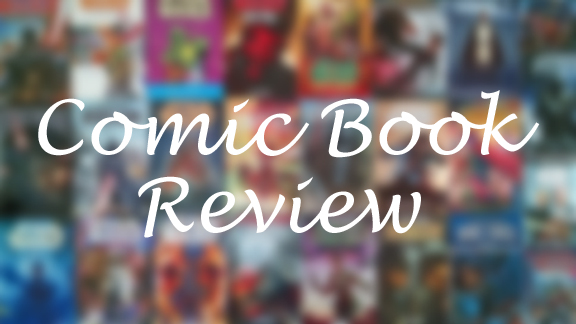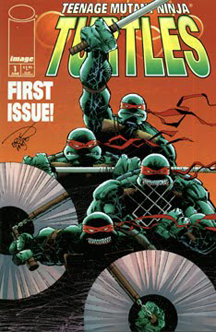Image Comics’ “Teenage Mutant Ninja Turtles” Volume 3, which ran for 23 issues from 1996-99, is sometimes called “The Lost Volume.” This is partly because it came out between the first peak of Turtles popularity in the early 1990s and the resurgence in the Aughts, partly because Peter Laird would later declare it non-canon (although it was the official Mirage continuation at the time of its release), and partly because most issues are hard to find (or at least pricey) on eBay.
Strange happenings
It’s also a volume that a lot of fans like to pretend didn’t happen, due to Don turning into a cyborg and Splinter becoming a mutant vampire bat; some also take issue with Raph gaining an eye patch and leading the Foot Clan, and Leo losing a hand. However, I’d argue that those things are all defensible within the flow of Gary Carlson’s story, as nothing happens merely for the sake of shock value.
Another reason it could be described as “The Lost Volume” is the artwork, penciled by Frank Fosco and inked by a variety of people. The impact of the strong pencils (Fosco draws Turtles similar to A.C. Farley in that they look like real turtles, but are still cuter than, say, Michael Zulli’s really real-looking turtles) is often “lost” because of weak inking and a complete lack of toning.

“Teenage Mutant Ninja Turtles” Vol. 3 Issues 1-8 (1996-97)
Writer: Gary Carlson
Pencils: Frank Fosco
Inks: Erik Larsen, Chance Wolf, Andrew Pepoy
I think Mirage’s use of duo-tones, eschewed by Image, is what makes their “TMNT” comics among the best-looking black-and-white books ever.
A good example of diminished artistic impact comes toward the end of Issue 8, when Michaelangelo disguises himself as a gargoyle so effectively that the mobster doesn’t even realize he’s resting his foot on Mike’s shell. It’s a great concept for a panel – and it inspired the cover art — as Mike is holding Shadow and shushing her with a finger to his lips.
But read it too fast and you might not notice Mike and Shadow are there at all. Even when you do pick them out (by this time, you will have learned to look at Image “TMNT” panels for longer than you do with the Mirage books), it lacks the power of seeing the full picture at first glance.
Sharp, but cold, writing
Almost entirely making up for the art’s lack of depth is Carlson’s writing, which does have depth and is easy to follow. The Komodo Dragonlord arc (1-5) is a fast-paced actioner, but then he slows it down nicely for the character-driven Kidnapping of Shadow arc (6-8), which brings April and Casey into the volume for the first time.
In the first arc, Carlson’s writing comes off as cold-blooded at times. Leo makes a quip about Raph not being voted the sexiest man alive immediately after Raph gets seriously wounded by a gunshot to the face. And Don had been shot and Splinter kidnapped just hours earlier!

In fact, even as Don is laying in a pool of his own blood and Splinter is in the clutches of Komodo’s henchwoman Pimiko, Mike says of the scantily clad villainess: “Whoa! I get first dibs on that tush!” Then Carlson plays the Turtles’ search for Donatello as a mystery (a good one, admittedly), even though his brothers find Don’s shattered shell and a skeleton, skimping too much on the emotional idea of losing a loved one.
All of this is rather indefensible, except to say that Carlson gets much better about writing emotions in the Shadow arc (I love how Shadow says “Unca Raffi” and “Unca Mikey”), and from the beginning he shows knowledge of personality traits and the Mirage continuity. I get the sense that he’s a big “TMNT” fan, not merely a hired gun; there’s clearly more passion in the scripting of these issues than was found in Lawson’s progressively weak Volume 2.
Time/age confusion
One more quibble: The Turtles celebrate their 18th birthday at the start of Volume 3, and I felt like they were in their early 20s in Volume 2. If they are 18, this story takes place in the late 1980s rather than in 1996. While Carlson doesn’t use any pop-culture or news references to contradict this, “Return to New York” and “City at War” did use news references that set those books in real time.
At any rate, Volume 3 opens six months after Volume 2 and the Turtles and Splinter are gathered in a sewer lair (presumably Leo’s, as he’s the only one with a sewer lair) having a birthday party.
As the battle against Komodo moves forward, we’ll see several of the locales Lawson introduced in Volume 2 – Casey and April’s apartment, Mike’s basement apartment, and Raph’s church cemetery mausoleum HQ (he seems to have the run of the grounds, for some reason). The Northampton farm doesn’t come into play; it seems Don and Splinter have moved in with Leo.
New developments
Komodo, who aims to bring his ancient Japanese clan back to prominence, is a strong villain; his scheme of experimenting with mutagen gives him a logical tie to our heroes, and I like the way he’s both evil and civil – sharing a cup of tea with Splinter even as he tells the rat with genuine regret that he must kill him because he knows too much. Pimiko is less layered – both figuratively and fashionably – but her revelation that she’s the daughter of Oroku Saki is a great twist in Issue 5.
While Raph’s eye patch seems perfect because we’ve seen Future Raph with an eye patch in “Choices” and “A Christmas Carol,” it’s less easy to handle Don being nearly killed by a fall from a helicopter but then being saved because cyborg armor (from a deceased victim of the fall) seeks a new host body and merges with Don.
Although it does seem to contradict the Future Don yarn “Old Times” (where Don is not a cyborg), I guess I gradually accepted Cyborg Don because Don himself does – a key sequence is a sparring session in Issue 6 where he learns the armor’s capabilities and how to control it with his mind.
Mirage tie-ins
In Volume 2, Issue 1, Casey worried about reverting to his old violent self around his daughter, Shadow, and his new live-in girlfriend, April (who, it must be noted, is drawn horribly by Fosco; suddenly she looks more like Megan Fox than the Lawson-drawn April we’d seen for the past 25 issues).
But Lawson fumbled his exploration of Casey’s fears, particularly blowing an opportunity in the Infiltration of D.A.R.P.A. arc when Casey goes all Ah-nold due to Braunze’s mental suggestion. Carlson makes up for that by showing Casey getting drunk, beating the hell out of street thieves, and even attacking Mike, who he blames for Shadow’s disappearance.
Another nice callback to the Mirage comics comes when Michaelangelo gets some of his poetry published. He had dreamed of becoming a TV writer in Volume 2, No. 1, and Volume 1, No. 17 is entirely a story told by Mikey to Klunk. While Mike probably can’t become a TV writer, he could become a “reclusive” poet or novelist; he could have a real life while not revealing that he is a mutant turtle.
Also refreshing: Splinter is portrayed as a ninja master – he helps Leonardo on the astral plane, and dispatches Komodo’s elite samurais – for the first time since … well, arguably since the early issues of Mirage Volume 1.
Also in the Shadow arc comes this neat twist: Raph has a relationship with the New York Foot Clan. It’s decidedly contentious, as they try to kill him after he fails to take out the crime kingpin in Issue 7, but there’s also some respect there. Raph’s relationship with his brothers is also just a bit contentious.
And because the Foot leader notes that the Clan is fracturing again – they fear Karai is dead – it sets the stage for Raph to take over the New York Foot, perhaps similar to various “Star Wars” stories where a Jedi thinks he can go to the Dark Side in order to defeat it.
But that’s a discussion for future yarns. While the art is problematic (but not a deal-breaker) in these first eight Image issues, Carlson’s narrative gets Volume 3 off to a pretty great start.

